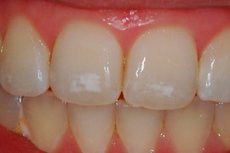Why do chalky spots appear on children's teeth?
Last reviewed: 12.03.2022

All iLive content is medically reviewed or fact checked to ensure as much factual accuracy as possible.
We have strict sourcing guidelines and only link to reputable media sites, academic research institutions and, whenever possible, medically peer reviewed studies. Note that the numbers in parentheses ([1], [2], etc.) are clickable links to these studies.
If you feel that any of our content is inaccurate, out-of-date, or otherwise questionable, please select it and press Ctrl + Enter.

When blood albumin enters insufficiently mature tooth enamel, its hardening processes may be disrupted, which provokes a reaction of molar incisor demineralization. People call this "chalky teeth". This conclusion was made by scientists, employees of the Australian University of Melbourne and the Chilean University of Talca. The experts recently published the results of their study on the pages of Frontiers in Physiology.
Dental hypo-and demineralization is a common disorder that is often diagnosed in pediatric dentistry. The problem is found in about 20% of children. In most cases, small patients complain of pain in the teeth, and parents note the appearance of grayish-white spots on the tooth surface and the early development of caries .
Why is the destruction of the structures that form the enamel coating? How does the function of ameloblasts change - cells that secrete the proteins enamelin and amelogenin, which undergo mineralization, forming enamel - the hardest substance in the human body? These questions have been troubling the scientific world for many decades, but the pathogenesis has not yet been fully elucidated.
In their new project work, scientists seem to come close to clarifying the situation of the appearance of demineralization and chalky spots on the tooth surface.
The researchers called the discovered pathogenetic scheme “mineralizing blockage”. The process is due to the local influence of blood albumin on not fully matured enamel. Whey protein forms a bond with mineral enamel crystals, which bridges the bond between calcium and phosphorus ions and growth points.
Amelogenin, a protein involved in the formation of the enamel coating, must have a full length containing a C-terminal telepeptide. In dentistry, amelogenin is used as a medication for the treatment of periodontitis, an inflammatory pathology of the root membrane of the tooth. There is also albumin that is resistant to the main protease, kallikrein-4, which is also involved in enamel hardening processes. Under the influence of kallikrein-4, amelogenin is destroyed, and albumin, as it were, adheres to the coating crystals and is preserved, disrupting the hardening processes. As a result, visual clear chalky opacities of a local nature are formed. The trigger mechanism in the development of this molar incisor disorder, apparently, is childhood diseases - in particular, those that are accompanied by a feverish rise in temperature.
The discovered information allows us to direct further research along the already clarified course. At the very least, scientists have positive prospects in order to start developing measures for the prevention and determination of a treatment regimen for chalky teeth.
For more information, see the frontiersin page.
